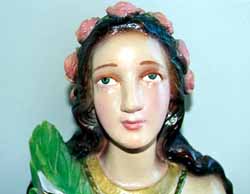Weeping statue of St. Philomena

November 14, 2000 - Reported [here]. Several people say a wet substance exuded by a statue of St. Philomena has cured their ills. Detroit's Chaldean Catholic archdiocese is investigating claims that a religious statue at a Sterling Heights gift shop weeps oil that devotees say heals cancer and other diseases.
The statue of St. Philomena -- honored in Warren at a special rosary and mass that brought out 150 people to pray Thursday, even though it was locked up in a sanctuary in Troy -- is at a secret location for now. This will give Metro Detroit's Chaldean priests time to substantiate the claims and the source of the oil, said Kevin Khadir, the owner of the All Saints store that bought the plaster statue of the Catholic martyr in August for $1,000 from a parish in Florida.
The Archdiocese of Detroit is skeptical. "We're not getting involved in that," Archdiocese of Detroit spokeswoman Corinna Weber said. At issue are contentions from eight people who say a wet substance they've touched from the St. Philomena statue cured their ills. "I have found something precious," Khadir said. Word of the cures has spread. People from as far away as Louisiana, Texas and California who learned of the healings in Internet chat rooms have come to Michigan to see the statue for themselves.
Believers abound, even though beneficiaries have declined to say how they have recovered so fast. "I have seen the statue and the oil. I believe," said John Alia, a 37-year-old plumber. Alia came from his home in West Bloomfield on Thursday to a mass spoken in Italian for St. Philomena at St. Edmund's church in Warren. The pastor of St. Philomena's shrine in Italy was at St. Edmund's to share a prayer, even though the statue wasn't there. Truck driver John Yarimian of Warren hopes oil from the statue can fix his bad hips. "I know people who were sick and now are not after touching a tear," said Yarimian, 43. "I hope for help, too."
Khadir acquired the statue in August from a Florida priest whose parish had bought a newer St. Philomena statue. The statue started leaking Aug. 26 and cried Oct. 31 while a priest examined it before taking it to St. Joseph's church in Troy for a closer look. "Before the oil comes out, her cheeks and hands get red," Khadir said. "Sometimes her hair drenches. Oil also comes from her hands, her anchor, the (palm) leaf and under her arms and feet. It's God's will." The statue's fate is unclear. Priests have told Khadir that the statue may be shielded from the public or rotated among churches for viewing. St. Edmund's parishioner Joan Flynn, 70, said the miraculous claims aren't far-fetched. "I don't know if praying to a statue helps. But I believe in God and I believe in miracles."
St. Philomena
* The daughter of a Greek king beheaded by emperor Diocletian in Rome, St. Philomena was ordered put to death as punishment for not marrying him. The emperor ordered archers to execute her with arrows, which, according to legend, turned back and killed the archers instead.
* The emperor then ordered her killed by tying an anchor around her neck and throwing her into water. But, according to legend, angels broke the rope and brought her to land with dry feet.
* She was beheaded after people who saw the miracles began to riot. Her body was found May 25, 1802, in the Catacombs of St. Priscilla at Via Salaria in Rome. She was believed to be 13 or 14 years old when she died.
She was declared a saint by Pope Leo XII. Over the years, many miracles have been attributed to St. Philomena, including the restoration of eyesight, the ability to walk and the reversal of paralysis.
See [here] page titled Saint Philomena statue exuded "manna", a miraculous oil.
